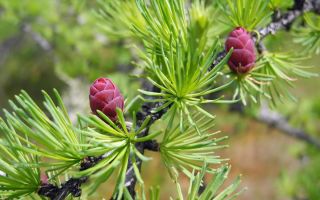Content
The medicinal and beneficial properties of larch are in demand in folk medicine. From the needles, cones and wood of a tree, effective healing agents are prepared for a variety of diseases.
What it looks like and where it grows
Larch (Larix) is a deciduous coniferous tree from the Pine family up to 30 m tall. The trunk of the plant is straight, slightly conical due to thickening in the lower part, the bark is smooth, gray-brown in color. Crohn narrow-pyramidal at a young age and wide cone-shaped in adults. Bright green needles are located spirally or singly on long shoots and in bunches on shortened ones, with the onset of autumn they completely fall off.
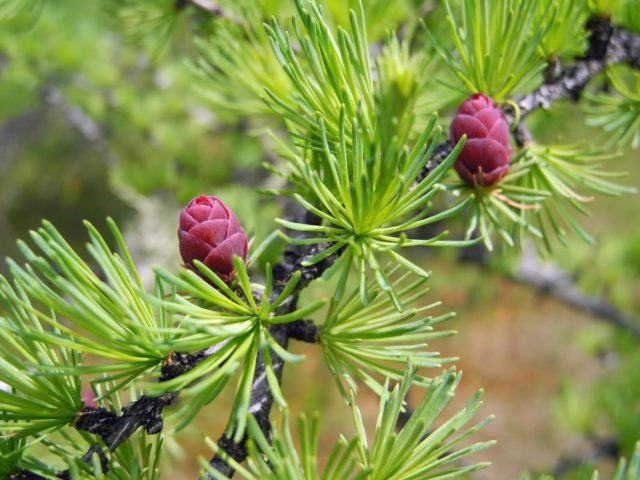
Larch blooms from April to June depending on the region, producing rounded yellowish male spikelets and reddish or green female cones. In autumn, they ripen and produce small, ovoid seeds with tight-fitting wings. Larch begins to bear fruit at the age of 15 years.
The tree can be seen in the temperate zone and subalpine and subarctic regions of Eurasia and North America. In Russia, larch grows mainly in Siberia and Altai.
Chemical composition
Needles, resin and cones contain a large amount of valuable substances. The plant raw materials contain:
- essential oils;
- organic acids;
- vitamin C;
- carotene;
- gum;
- tanning components;
- fixed oils;
- anthocyanins and catechins;
- flavonoids;
- glycosides;
- lignin.
The benefits of larch for humans lie in its anti-inflammatory and sedative properties. The plant promotes the healing of skin lesions. Traditional medicine uses wood raw materials to create diuretics, cleansing and antimicrobial agents.
Useful properties of larch
All parts of the plant can be used to promote health and fight ailments. With proper use, larch:
- normalizes the nervous system and regulates sleep;
- helps with colds and fever;
- has an antitumor effect;
- acts as a natural laxative for constipation;
- helps with excessively heavy periods in women;
- promotes expectoration with bronchitis;
- improves the condition of renal diseases;
- beneficial for rheumatism, arthritis and gout;
- relieves toothache;
- has an antiseptic effect on inflammation and suppuration.
The health benefits of larch can be used to reduce blood pressure and to strengthen the cardiovascular system. Plant raw materials normalize metabolism and improve digestive processes.
The medicinal properties of Siberian larch
Siberian larch is most widespread on the territory of Russia, the tree occupies about 40% of the area of all forests. The plant is widely used in folk medicine; for the preparation of medicines, they take needles and bark, resin and kidneys.
Siberian larch helps with colds and ailments of the respiratory system. Means based on the plant can fight gastrointestinal disorders and edema. Ointments and balms based on natural raw materials are used in the treatment of joint ailments and skin irritations.
The benefits of larch cones
In the spring, small cones form on the branches of the tree, bringing seeds closer to autumn. Traditional medicine uses them to treat coughs and colds, with nervous disorders and cardiovascular diseases.
The beneficial properties of young larch cones collected in May are mainly used. On their basis, not only infusions and decoctions are prepared, but also homemade honey, which helps in the treatment of asthma, vitamin deficiency, intestinal and gastric disorders. Old cones are not used for therapeutic purposes.
The benefits of larch cone jam
One of the options for using larch buds, or young cones, is to make jam, sweet, but with light sour notes. You can use such a delicacy not only for pleasure, but also for medicinal purposes. Jam helps with ARVI and flu, lowers the temperature. It brings benefits in case of disturbed metabolism, vitamins and organic acids in its composition help to improve appetite and accelerate digestion.
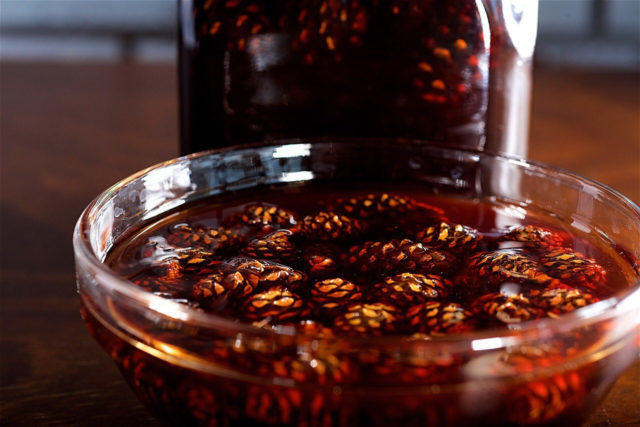
Useful properties of larch needles
Larch needles are most widely used in folk medicine. It is used for the preparation of infusions and teas, decoctions and strong tinctures. Conifers have a beneficial effect on:
- bleeding gums and scurvy;
- colds and weakened immunity;
- cough;
- toothache and periodontal disease;
- tendency to obesity;
- rheumatism and gout.
The beneficial properties of larch leaves are due to the high content of vitamin C. Raw materials are beneficial for any inflammation. Needle-based products can be applied externally for quick healing of injuries.
Medicinal properties of bark, larch wood
Larch bark and wood are valued primarily for their high tannins content. The raw materials have pronounced astringent properties and are used for diarrhea. In addition, funds based on woody parts are used in the treatment of hemorrhoids and prostatitis due to their anti-inflammatory and hemostatic action.
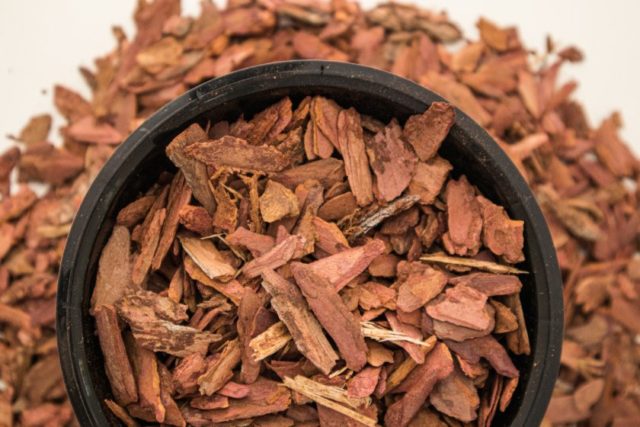
The bark can be used to treat heart failure, intestinal infections and painful periods. Raw materials are used externally for abscesses and trophic ulcers, and solutions for rinsing are prepared for inflammation of the oral cavity.
The medicinal properties of larch resin
The beneficial properties of larch gum are used primarily for the treatment of respiratory diseases - pleurisy, pneumonia, tuberculosis. Alcohol tincture based on raw materials demonstrates good effectiveness in rheumatism and radiculitis, as it improves joint mobility and relieves pain.
The benefits of a larch broom
The larch tree is used in the manufacture of coniferous brooms for a bath, they strengthen the body and improve overall well-being. Steaming them helps with bronchitis and tuberculosis. Larch brooms warm up the joints, promote wound healing and epidermis restoration in case of inflammatory ailments. Steaming cleanses the body and effectively removes toxins through the skin, has a beneficial effect on the condition of the liver and kidneys.
Preparation and application methods
Traditional medicine offers several recipes using the healing properties of larch. On the basis of plant raw materials, strong tinctures and water products are prepared.
Tincture
Alcohol tincture is made from fresh needles. The cooking recipe looks like this:
- 150 g of raw materials are poured into 250 ml of vodka;
- closed for three weeks, removed in a dark place;
- after the time has elapsed, passed through cheesecloth.
You need to take the drug three times a day, 20 drops, after diluting the drug in 10 ml of water. The medicine helps with colds and neuralgia, has a strengthening effect in diarrhea.
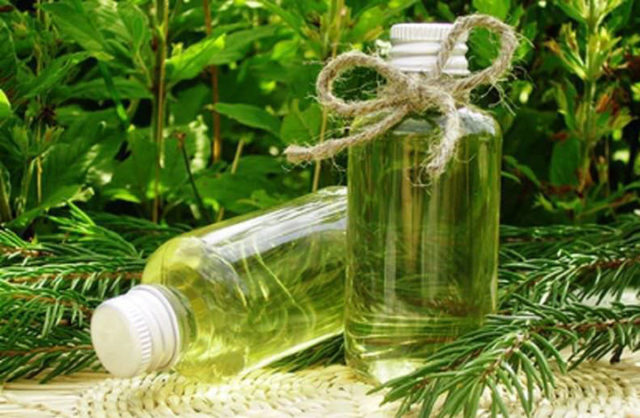
Another recipe suggests using the medicinal properties of larch resin to prepare the tincture. Make the tool like this:
- 100 g of resin is poured into 600 ml of alcohol 96%;
- kept in a dark place for 20 days;
- filtered.
Take a remedy for intestinal parasites, ten drops per 100 ml of water three times a day.
Infusion
Water infusion is made from needles and young larch buds. The cooking algorithm looks like this:
- 40 g of dry or fresh raw materials are poured into 500 ml of boiling water in a thermos;
- leave closed for an hour;
- passed through cheesecloth for filtration.
After the infusion has cooled down to about 40 ° C, honey or lemon juice can be added to it. Drink should be taken in 250 ml twice a day for colds or to strengthen the immune system.
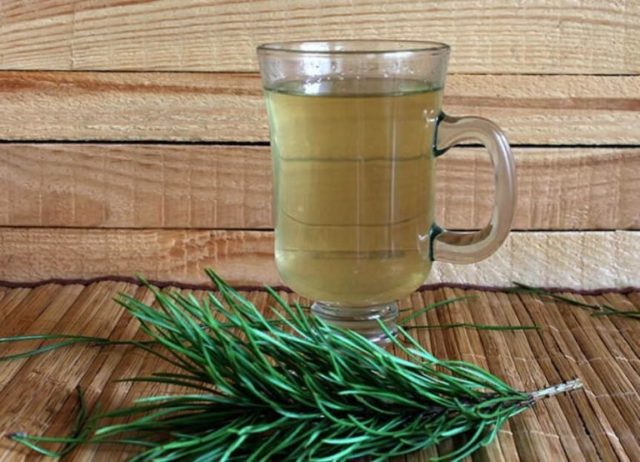
Decoction
The benefits of larch needles are used to prepare a decoction. The remedy improves the condition for respiratory ailments and inflammations, and they do it as follows:
- 15 g of dry or fresh needles are poured into a glass of liquid;
- in a water bath, simmer the product for 15 minutes;
- stand under the lid for another three hours;
- filter through cheesecloth and cool.
They drink the broth three times a day for 1/3 cup, if desired, you can add sea buckthorn or cranberry juice to the drink.
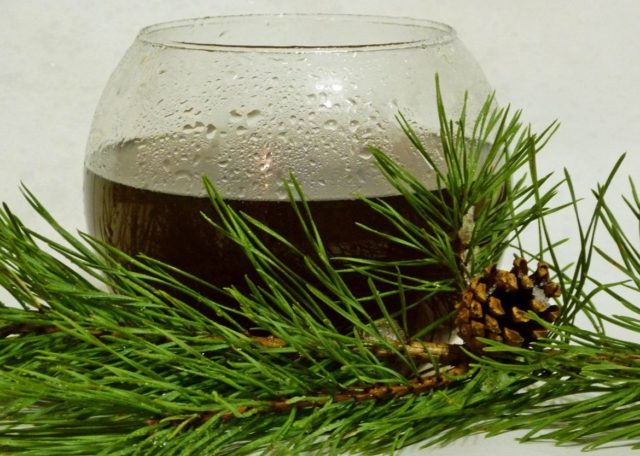
Fresh application
Larch can be used for treatment not only after processing, but also fresh. For example, in case of inflammation and bleeding of the gums, the needles of a plant, crushed into gruel, are used, which will also help to eliminate bad breath.
With diabetes mellitus, acute toothache and gastritis, the benefits and harms of larch chewing gum manifest themselves. A small piece of resin must be absorbed and rolled in the mouth for 15 minutes.
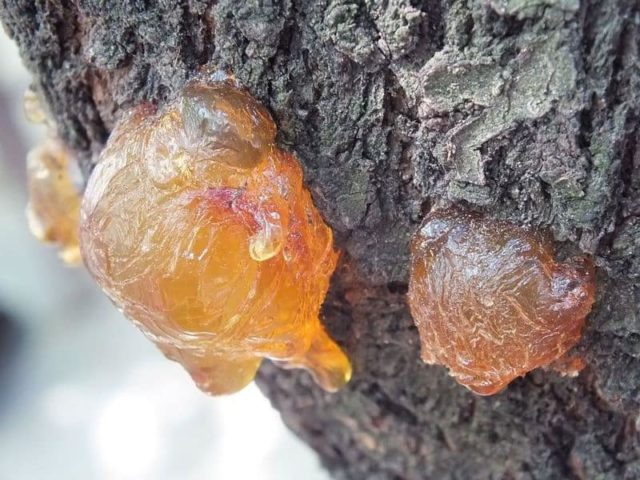
The use of larch in folk medicine
The medicinal properties of larch are beneficial for many diseases. Traditional medicine recommends proven application algorithms and indicates safe dosages.
With increased pressure
A water decoction from the needles of a plant helps with hypertension, which strengthens blood vessels and improves their permeability. The cooking recipe looks like this:
- two large spoons of dry raw materials are poured into a glass of water;
- bring to a boil;
- boil over low heat for ten minutes;
- cooled and passed through cheesecloth.
You need to consume the broth in 80 ml on an empty stomach three times a day. In total, the medicine is used until the pressure normalizes, but not longer than two weeks in a row.
When coughing
With prolonged cold cough and bronchitis, larch tincture promotes sputum discharge. It is prepared as follows:
- 50 g of fresh needles are poured into 500 ml of high-quality vodka;
- put in a dark place for three weeks;
- removed periodically to shake;
- after a lapse of time, filter through folded gauze.
You need to take the medicine 20 drops up to three times a day. The drug is preliminarily diluted in half a glass of clean water.
With pneumonia
Gum, or larch resin, has strong reducing properties. The following mixture is beneficial for pneumonia:
- the resin is poured with warm water, the liquid should cover the raw material by 1 cm;
- the agent is kept for half an hour, stirring occasionally, until the gum is completely dissolved;
- the infusion is mixed in a ratio of 1: 2 with lard and slightly heated in a water bath;
- after the product acquires a liquid consistency, remove from the stove and cool to a warm state.
15 g of natural honey is added to the infusion and the components are mixed properly. You need to take the remedy in a small spoonful three times a day. In total, treatment continues until the body is fully restored.
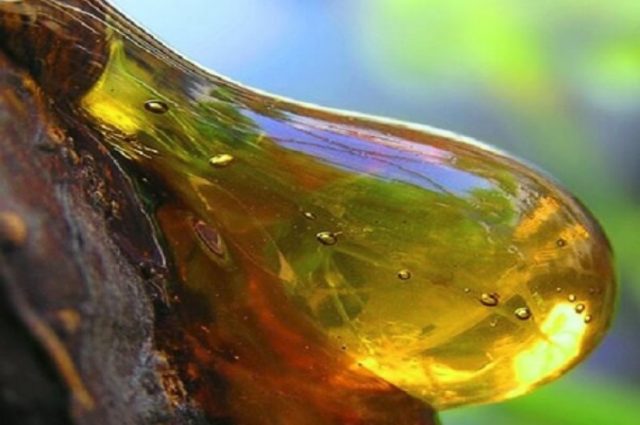
For constipation
A decoction in milk has a good laxative effect. It is simple to prepare it:
- 20 g of fresh needles are poured into 200 ml of milk;
- simmer on low heat for no longer than 15 minutes;
- filter through a layer of gauze.
Take 30 ml twice a day. The broth can also be used to remove parasites from the intestines.
With a fever
At elevated temperatures, an infusion of dried larch needles helps to improve health. The recipe looks like this:
- 500 g of raw materials are finely chopped;
- pour 1 liter of boiling water in a thermos;
- hold under the lid for three hours, then filter.
You need to take the medicine 50 ml twice a day until the condition improves. Larch relieves heat, removes toxins from the body and accelerates recovery.
Contraindications
Useful properties and contraindications of larch needles are not always the same. It is not recommended to consume plant materials:
- with a stomach ulcer in the acute stage;
- with increased acidity;
- with individual allergies;
- with exacerbation of pancreatitis;
- with a recent stroke or heart attack;
- with serious chronic diseases of the nervous system.
You should not take infusions and decoctions of larch during pregnancy and breastfeeding. Herbal remedies can negatively affect the condition of the fetus or cause allergies in the newborn.
Collection and procurement
Siberian larch needles can be harvested throughout the summer. But most often it is harvested in late June or early August, when the most vitamin C accumulates in the needles. The buds are harvested in early spring before the covering scales open, and the resin is obtained during the active growing season by the hooking method.
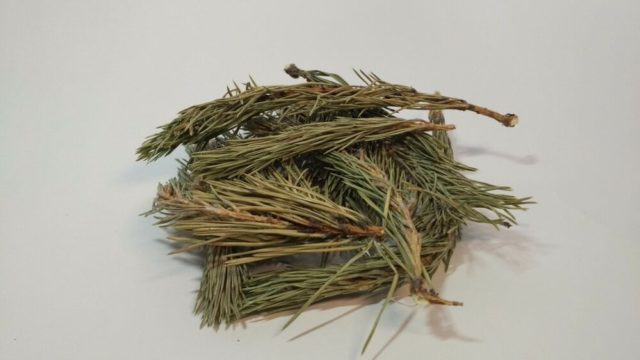
The needles and buds are often used fresh, but they can be dried if necessary. For this, the raw materials are laid out in a warm place in the shade with good ventilation until the moisture evaporates completely. The bark is also dried, but first boil it in order to reliably eliminate possible microorganisms. It is necessary to store raw materials in glass containers or paper bags at a temperature not exceeding 25 ° С in a dark place.
Conclusion
The medicinal and beneficial properties of larch allow it to be used for the treatment of colds, inflammatory and intestinal ailments. Raw materials of the plant are used in fresh and dried form by internal and external methods. The coniferous tree is especially prized in the treatment of respiratory diseases.

